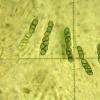
15-12-2025 15:48
 Danny Newman
Danny Newman
Melanospora cf. lagenaria on old, rotting, fallen

15-12-2025 15:54
 Johan Boonefaes
Johan Boonefaes
Unknown anamorph found on the ground in coastal sa

15-12-2025 21:11
 Hardware Tony
Hardware Tony
Small clavate hairs, negative croziers and IKI bb

15-12-2025 07:09
 Danny Newman
Danny Newman
indet. Rutstroemiaceae sp. on unk. fallen leavesMc

15-12-2025 07:05
 Danny Newman
Danny Newman
Pseudosclerococcum golindoi (det: Zotto)near Cosb

15-12-2025 11:49
 Danny Newman
Danny Newman
ITS sequences from the following two collections B

15-12-2025 12:34
 Danny Newman
Danny Newman
indet. Rhytismataceae on oak leafnear Purchase Roa

09-12-2025 12:06
 Andgelo Mombert
Andgelo Mombert
Bonjour,Je recherche l'article concernant Hypobryo
Sporormiella?
Bernard Declercq,
18-10-2010 20:40
 Hello,
Hello,I recently collected a pyrenomycete on very decayed wood of Quercus robur, with immersed to semi-immersed subglobose ascomata 0,35-0,5 mm diam., non-papillate, with a central pore, rugulose, black. Asci are bitunicate, cylindrical, 2-spored (!), 68-77x7-8 µm. Spores are cylindrical, smooth, dark grey, oblique 3-septate, rarely 2- or 4-septate, constricted at the septa, (12,5)17-19,5(20)x5,5-6µm, no germ slits observed nor gelatinous coating, with two large guttule and many small ones per cell.
Such spores are Sporormiella-like, but lignicolous species are rare in this genus. Any idea?
Herewith a photo of the asci.
Thanks in advance,
Bernard
Bernard Declercq,
18-10-2010 20:41

Re:Sporormiella?
... and here a photo of the ascomata.
Jacky Launoy,
19-10-2010 10:30
Re:Sporormiella?
Bernard,I dont' see the picture of the ascomata
Jacques Fournier,
19-10-2010 14:47

Re:Sporormiella?
Bernard,
asci on your photo are unitunicate, they have a discoid apical ring and ascospores lack germ slits, therefore it cannot be a Sporomiella.
Your fungus likely belongs to Synaptospora Cain, in which one-celled ascospores are stuck in groups of 2-3-4 within the ascus.
Characters of the peridium and ascospores are needed to attempt an identification.
Cheers,
Jacques
asci on your photo are unitunicate, they have a discoid apical ring and ascospores lack germ slits, therefore it cannot be a Sporomiella.
Your fungus likely belongs to Synaptospora Cain, in which one-celled ascospores are stuck in groups of 2-3-4 within the ascus.
Characters of the peridium and ascospores are needed to attempt an identification.
Cheers,
Jacques
Bernard Declercq,
20-10-2010 13:33

Re:Sporormiella?
Merci Jacques pour cette indication intéressante. Avec les ascomes à verrues et des spores de 6,5-8,5x5-5,7 µm, me basant sur la clef de Reblova (2002), j'arrive à Synaptospora petrakii Cain, espèce décrite sur Betula au Canada. Est-ce que l'espèce a été déjà trouvée en Europe?
Bernard
Bernard
